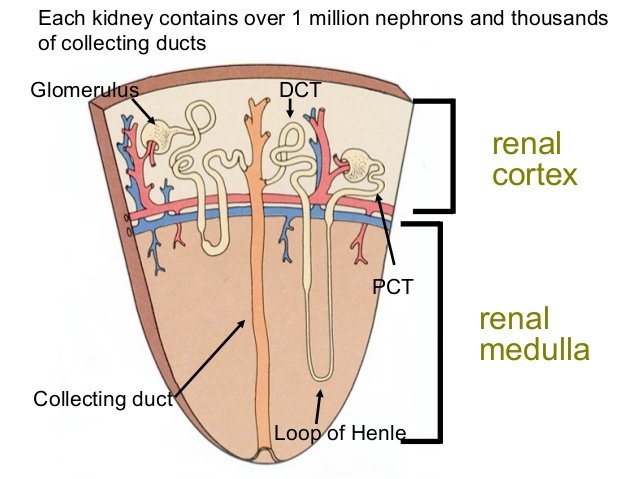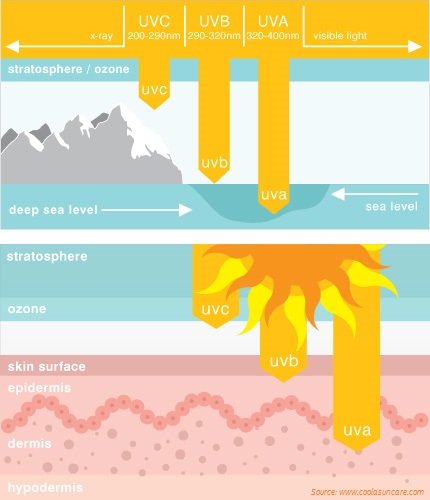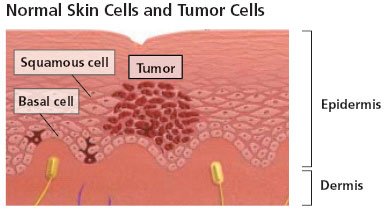Hydrochlorothazide is a drug which is commonly used for the conditions like hypertension, Chronic heart failure, cirrhosis and renal dysfunctions. It is also used in the cases of glucocorticoid therapies. But, mostly it is used in cases of hypertension and Chronic heart failure. This has been used world wide till now in cases of hypertension mostly. This drug increases the risk for skin cancer SEVEN times !
YES ! SEVEN TIMES ! WHICH IS 700 % !
Firstly, knowing the Distal convoluted tubule is important than going through the mechanism of hydrchlorothiazide.

Distal convoluted tubule [physiology and anatomy of urinary system]
DCT is a part of nephron. This lies downstream if the kidney. This is a short segment of the nephron which is only 5mm in length. It play a major role in homeostatic process like sodium and chloride reabsorption, calcium and magnesium handling and also potassium secretion. DCT ansorbs roughly about 5%-10% of the filtered sodium load where Na+ Cl- symporter plays a major role in it. For the thiazide diuretic to occur, it binds to this channel. This part of nephron has a strong contribution in making some changes during hormonal stimuli, various other clinical scenarios. During loop diuretic resistance as well as during hyperaldosteronism, it provides a major role in use. [1]
Mechanism :
Hydrochlorothiazide lies in the Thiazide Diuretic ; Antihypertensive Classification.

Hydrochlorothiazide - Mechanism of action [2]
In the distal convoluted tubule of nephron, thiazide diuretic acts on the Na+/Cl- Symporter Channel. It blocks them by binding with the Cl- ion. This halts the entrance of Na+ and Cl- from the lumen of the nephron or filtrate to the epithelial cells of the DCT. By this process, certain concentration of ion decreases in the DCT epithelial cells. Concentration of ion increases outside the epithelial cells or in the lumen of DCT region. This makes more concentration of Na+ and Cl- in the urine.
When Na+ and Cl- are excreted along with the water, blood pressure decreases . Also, vaso-dilatation of arteriole occurs which can help out with blood pressure and excretion of fluid out of the body. As many diuretic can lead to decrease of electrolytes and cause hypomagnesemia, hypokalemia, hypophosphatemia, hyponatremia as well as dehydration. So, patients like renal or kidney disease are not prescribed. [3]
To the topic :
Study led by Anton Pata Gard who is a associate professor of Pharmacology said "Commonly used hypertensive drug ; hydrochlorothiazide, proves sunburns ". Now, it raises it's risk of lip skin cancer by seven times.- Findings [4]
"Every Cloud Has A Silver Lining ! "
Danish scientist sharted Examination of relationship between hydrochlorothiazide and skin cancer.In the past, Link that they found was that Hydrochlorothiazide had some increased risk in developing lip cancer. Study showed that 11% of people had lip cancer from the cases of hydrochlorothiazide drug therapy. The drug makes the skin more and more sensitive to damage by Ultraviolet rays (UV rays) and sunbeads. It occurs by the photosensitizing effects. Danish scientist used the nationwide Danish health registeries which had almost all cancer diagnosis and use of drugs for all the cases in the Danish population. This made the scientist investigate with great precision. Isn't it smart enough ?
So what did they literally do ?
They took a population of around 800 thousand patients diagnosing with a skin cancer ; non-melanoma type . On the other side, they took a milion or half of population without skin cancer. They found out through surveys that how many of the people had been into hydrochlorothiazide drug therapy in the non cancer patient as well as to the skin cancer patient.
THE RESULT WAS CLEAR ! - Result
However, the relationship isn't directly causative. The higher the hydrochlorothiazide a person had used, the more risk they face towards the skin cancer. From the result, the most common cancer known as Basal Cell carcinoma had increased in the population by 30% for the long-term therapy users. Whereas, the less common skin cancer; Squamous cell carcinoma showed a stronger relationship with the hydrochlorothiazide user.
Long term users had around four-fold increase to 7 fold-increase with skin cancer. If the study group, stopped using the hydrochlorothiazide, 1 out of 10 person would be safe from risk of skin cancer. [5]
So, how does skin cancer arise ?
If we are exposed to excessive sunlight and also to this UV radiation so called Solar radiation for too long, we are benefited from the detrimental causes of harms. Most serious is the skin cancer.

Classification of UV rays [6]
Generally, UV light according to it's wavelength, it is classified into three ranges :
UV-A (400nm-320nm)
UV-B (320nm-290nm)
UV-C (290nm-100nm)
UV-A penetrates the deeper skin layers when comparing with UV-B and UV-C. When this UV-A and UV-B enters the skin surface, stimulates the production of melanin pigment. Melanin pigment is a type of pigment that gives the skin, hair and eyes their color.
UV rays entering the skin surface not only produces melanin pigment which is visible similar to tan but it also damages the collagen fibres linked. Damage to collagen creates a aggregation of proteins which makes the skin irritant. Redness and sunburn are visible through our naked eyes. Later, thickening of skin occurs which is followed by wrinkling and loss of elasticity of skin.

Difference between Normal and tumor cell
(source)
Reactive oxygen species are formed when there is triggering by UV-A and UV-B. These are capable in destroying lipid protein. These also destroy other cell components which is irreversible in nature i.e. producing irreversible cascade of destruction. So,exposure to UV radiations for longer time can increase the risk for skin cancer.
On the case of UV-B rays, it directly damages the DNA directly. From the neighboring thymine or cytosine, It forms pyrimidine dimers by base pairs or maybe from the reactive oxygen species which can cause strand break at some instances. For normal DNA structure, you can see the Watson and crick model.
Conclusively, hydrochlorothiazide just makes the skin more sensitive to the Ultra-violet rays which increases the risk for skin cancer. It should be weighted against the known benefits of using this drug. Since there are many other hypertensive drugs which has no relation in risk for skin cancer, use of hydrochlorothiazide can be limited.
From this point we can hopefully use other safer antihypertensive drugs and treatments in the future. Any harmful and serious consequences on health doesnot imply on skin cancer. It is important not to discontinue the antihypertensive treatment without consulting or taking advise from the physician.
Reference :
Mentioned along with the article . Further references-
Hydrochlororthiazide on cardiology :JOURNAL OF THE AMERICAN COLLEGE OF CARDIOLOGY
Hydrochlorothiazide risk for nonmelanoma skin cancer : Case control study from denmark : JOURNAL OF AMERICAN ACADEMY OF DERMATOLOGY
(Grant from the Danish Cancer Society (grant R72-A4417) and the Danish Council of Independent Research (grant 4004-00234B)
Medical News:Medscape News on hydrochlorothiazide risking skin cancer
Italian supporter of #steemSTEM project ! Sostenitore italiano del progetto #steemSTEM!
Thanks to the @steemstem community for creating #steemSTEM tag where steemit community can read such good articles and post relating to the Science, Technology, Engineering and Mathematics. Do support the steemSTEM community.
To be member of this community, join on:
Steemit.chat channel : https://steemit.chat/channel/steemSTEM
Discord: https://discord.gg/mKSKQ7T

This post has received a 3.12% upvote from @msp-bidbot thanks to: @medical-hall. Delegate SP to this public bot and get paid daily: 50SP, 100SP, 250SP, 500SP, 1000SP, 5000SP Don't delegate so much that you have less than 50SP left on your account.
Hey, this is an amazing post well done! I wonder if this will start getting taken into consideration in best-practice guides anytime soon?
I'm from Australia where the rates of BCC, SCC and Melanoma are higher than anywhere else in the world, so this is really relevant and it's something I'm super glad I've learned.
I almost never re-steem but I think this deserves it! Great post!
Bingo! There is someone who likes my post. Thanks for going through my post. And leaving a comment there.
Hope Australia finds some solution sooner or later now.
very well done post. upvoted/followed.
Thanks toxicologist !
Congratulations @medical-hall! You have completed some achievement on Steemit and have been rewarded with new badge(s) :
Click on any badge to view your own Board of Honor on SteemitBoard.
For more information about SteemitBoard, click here
If you no longer want to receive notifications, reply to this comment with the word
STOP